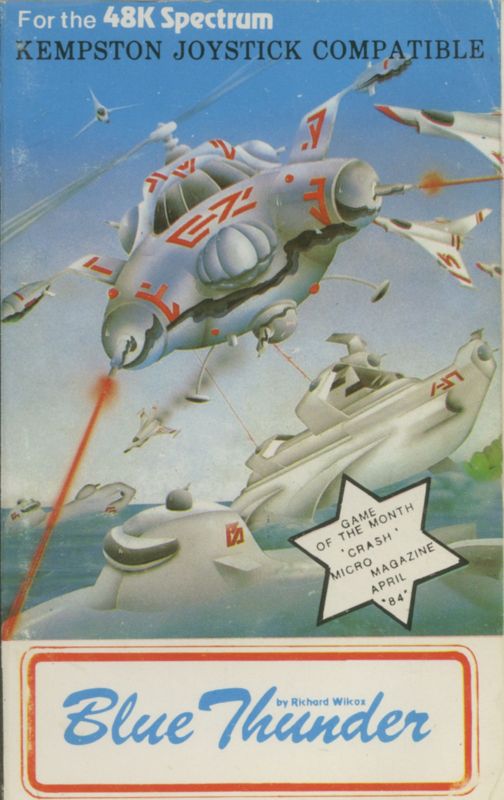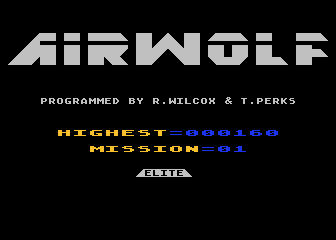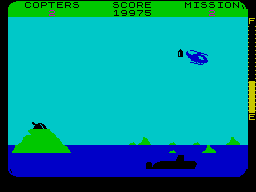Retro Replay Review
Gameplay
Blue Thunder throws you straight into the cockpit of a high-tech “jetcopter” in a classic side-scrolling shooter format. You’re the sole survivor of an alien ambush and must navigate through a chain of fortified islands to reach the enemy stronghold. The controls are responsive, allowing you to hover, bank, and fire in any direction—even straight down—giving you a satisfying sense of aerial freedom and tactical flexibility.
(HEY YOU!! We hope you enjoy! We try not to run ads. So basically, this is a very expensive hobby running this site. Please consider joining us for updates, forums, and more. Network w/ us to make some cash or friends while retro gaming, and you can win some free retro games for posting. Okay, carry on 👍)
Fuel management adds an extra layer of challenge: you can’t simply blaze through levels with reckless abandon. Every maneuver and burst of gunfire eats into your limited reserves, forcing you to balance aggressive play with careful conservation. Collecting fuel pickups becomes a frantic part of the experience, turning open skies into strategic battlegrounds where every corridor and island gap matters.
Enemy variety keeps things fresh. On the standard difficulty you’ll face ground turrets, patrol boats, and low-flying aircraft. Defeating each wave unlocks the next island cluster, but success only grants you access to a tougher loop with faster-firing foes, barrage balloons, and missile-armed submarines. This cyclical progression ensures the gameplay stays challenging, rewarding mastery while keeping you on your toes.
The option to replay at heightened difficulty levels extends the game’s lifespan significantly. As you grow accustomed to enemy patterns, the increasing pace and density of threats force you to refine your tactics. Veteran players will appreciate the rising stakes, while newcomers can enjoy a well-paced learning curve before tackling the toughest settings.
Graphics
On the Commodore 64, Blue Thunder’s sprite work is sharp and colorful, making each helicopter, turret, and palm-fringed island stand out against the ocean backdrop. The side-scrolling effect is smooth, though it scrolls in the opposite direction compared to some contemporaries—an odd quirk that takes a moment to adjust to but ultimately feels unique.
The environmental graphics capture a tense, militarized world: steel-grey towers, camouflaged bunkers, and subtly animated water surfaces that ripple as you fly low. Small flourishes—like explosions that linger in the sky or shadowed aircraft silhouettes on the horizon—add atmosphere, elevating what could have been basic set dressing into immersive, dynamic scenery.
The Atari 8-bit version introduces minor graphical tweaks, notably in the environmental textures and color palette. Though fundamentally the same design, the re-release under the Airwolf license replaces the Blue Thunder model with a sleeker chopper and adjusts some interface elements. Fans of retro visuals will find charm in these subtle platform differences.
While primitive by today’s standards, Blue Thunder’s graphical presentation remains clear and functional. Enemies are easily distinguishable, projectiles are visible against both sky and land, and the HUD keeps vital information—fuel, lives, and current level—in view without obstructing the action. It’s a clean aesthetic that serves the gameplay rather than overshadowing it.
Story
The narrative premise is deceptively simple: you are the last pilot of Blue Thunder after an alien assault has devastated your fleet. Alone and underpowered, you’re tasked with infiltrating a series of hostile islands to disable defenses and rescue your comrades. Though minimalistic, this setup provides immediate motivation and stakes.
While in-game story beats are conveyed mostly through brief text screens, the sense of urgency is palpable. Each mission brief reinforces the feeling of being humanity’s last hope, and the progression from one island to the next mimics the high-tension sequences of the short-lived TV series. If you’re familiar with the show, you’ll appreciate the authenticity of the tie-in elements.
There’s limited character development or cutscene exposition, but the game doesn’t pretend to be a cinematic epic. Instead, it focuses on delivering an arcade-style journey where your piloting prowess writes the story. Every crashed turret and downed drone feels like a small victory in your broader rescue operation.
For players seeking a narrative-rich adventure, Blue Thunder may feel light on plot detail. However, its streamlined storytelling fits its breakneck pace. The context it provides is just enough to drive the action and give meaning to each mission, without bogging you down in lengthy dialogue or exposition.
Overall Experience
Blue Thunder offers a compelling blend of tight controls, strategic resource management, and steadily ramping difficulty. Its arcade roots shine through in the pick-up-and-play accessibility, yet it rewards dedication and skill with deeper layers of challenge. For fans of side-scrolling shooters, it stands out as a memorable retro title.
The game’s replay value is anchored by its escalating difficulty loops: once you clear the initial run, the heightened enemy aggression and new hazard types make subsequent attempts feel like fresh experiences. Coupled with the fuel-management twist, Blue Thunder avoids the trap of rote memorization, insisting you stay alert and adaptive.
Audio design is functional and moody, with chiptune rhythms that underscore the tension without becoming intrusive. Simple explosion effects, alert beeps for low fuel, and the jet’s whirling rotor sounds all contribute to an immersive cockpit feel. It’s not a full-blown soundscape, but it does the job—and adds to the retro charm.
In sum, Blue Thunder is a satisfying retro shooter that balances action and strategy. Its visual quirks, terse but effective story, and escalating difficulty curve combine into an experience that’s as rewarding today as it was on release. Whether you’re a nostalgist or a newcomer curious about 8-bit design, this jetcopter adventure is well worth a test flight.
 Retro Replay Retro Replay gaming reviews, news, emulation, geek stuff and more!
Retro Replay Retro Replay gaming reviews, news, emulation, geek stuff and more!









Reviews
There are no reviews yet.